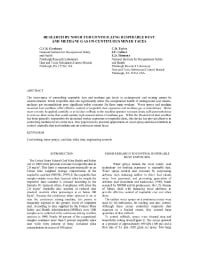Mining Publication: Research by NIOSH for Controlling Respirable Dust and Methane Gas on Continuous Miner Faces
Original creation date: January 2001
Authors: GV Goodman, CD Taylor, JF Colinet, ED Thimons
NIOSHTIC2 Number: 20021320
Proc Seventh International Mine Ventilation Congress, 2001, Krakow, Poland, 2001 Jan; :237-241
The United States Federal Coal Mine Health and Safety Act of 1969 limits personal exposure to respirable dust to 2.0 mg/m3. This limit is measured gravimetrically as an 8-hour time weighted average concentration of the respirable coal dust (NIOSH, 1995). If the respirable dust sample contains more than 5 percent silica by weight, the respirable dust standard is reduced according to the formula 10 / (percent silica). Compliance with either the 2.0 mg/m3 respirable dust standard or reduced dust standard maintain silica percentages at or below 100 Fg/m3. Because the continuous miner operator is on or near the continuous mining machine, this person is frequently exposed to the greatest levels of respirable dust. According to data supplied by the Federal Mine Safety and Health Administration (MSHA), over 3100 samples were collected at the continuous mining machine operator in 1998. Nearly 60 percent of the occupational samples contained more than 5 percent respirable silica dust while forty percent of these contained silica concentrations in excess of 100 micro g/m3.

NIOSHTIC2 Number: 20021320
Proc Seventh International Mine Ventilation Congress, 2001, Krakow, Poland, 2001 Jan; :237-241
- Composition Change Model for Sealed Atmosphere in Coal Mines
- Controlling Respirable Dust in Underground Coal Mines in the United States
- Dust Underfoot: Enclosed Cab Floor Heaters Can Significantly Increase Operator's Respirable Dust Exposure
- Evaluation of the Approach to Respirable Quartz Exposure Control in U.S. Coal Mines
- Historical Development of Technologies for Controlling Methane in Underground Coal Mines
- Improving Silica Dust Control Through Targeted Research
- Laboratory Testing To Quantify Dust Entrainment During Shield Advance
- An Overview of Fundamental and Emerging Technologies to Monitor and Control Respirable Dust in Underground Coal Mines in the United States
- Peak Methane Concentrations During Coal Mining: An Analysis
- Rotary Drilling Techniques Used in the Beckley Coalbed